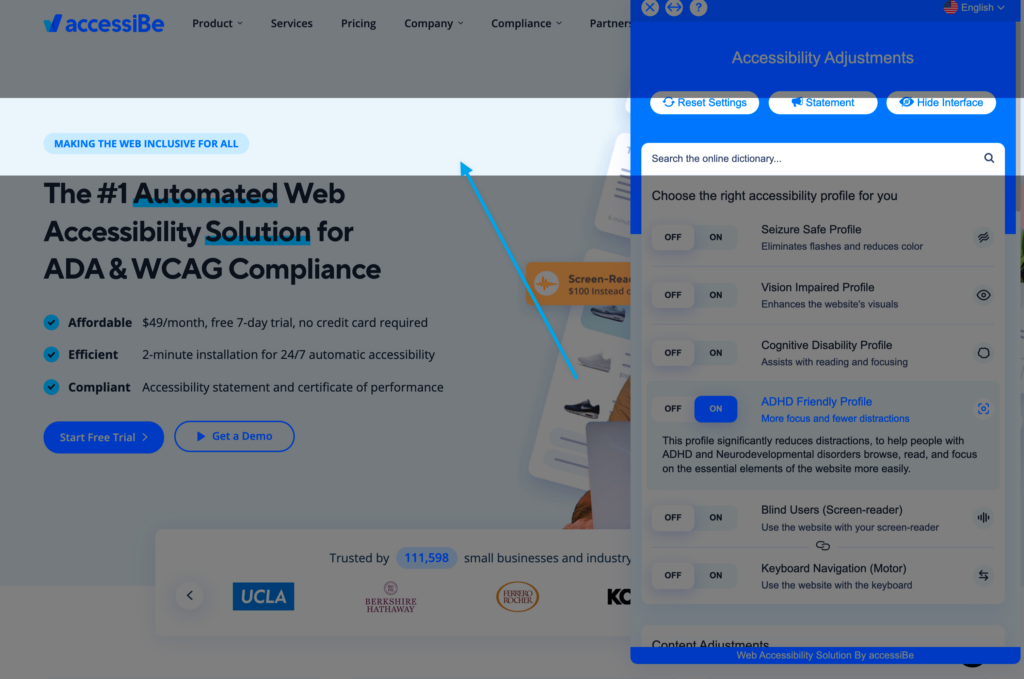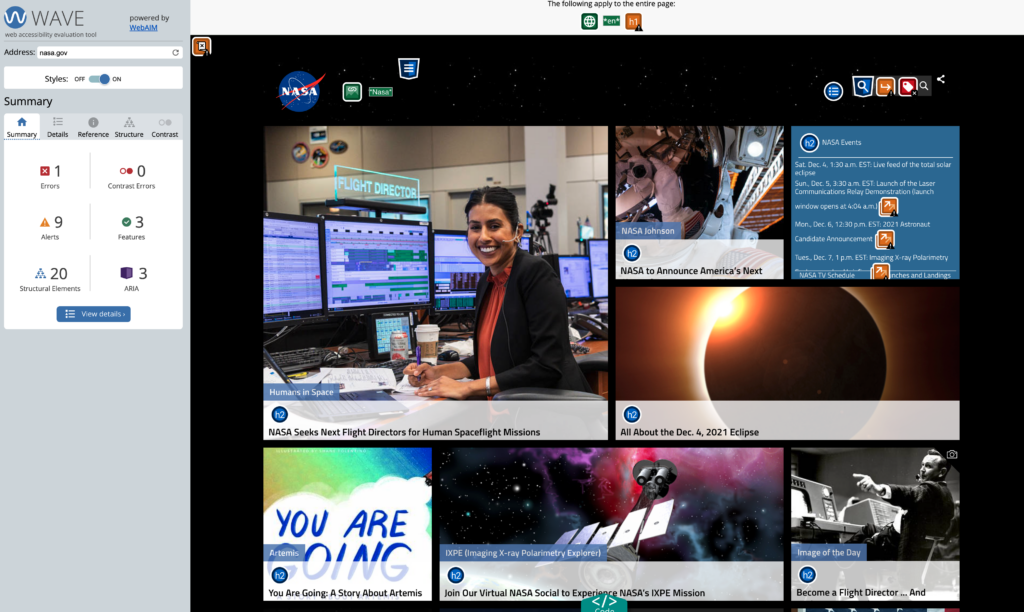
The goal of this article is to explain the general concepts of ADA compliance for your nonprofit WordPress website and options to work towards compliance.
And the main spirit of this article is that we all want our websites to be accessible by everyone, and anyone. It is estimated that ~25% of the population experiences some sort of disability. As a nonprofit WordPress website owner, you want to serve all visitors, regardless of ability.
More and more frequently, WPBacked.com Pro customers have been asking our team about ADA compliance.
Having your organization’s website be ADA compliant has always been something you may have wanted for your website. And a potential catalyst for many website owners is the threat, or a current legal claim, for not being ADA compliant.
Almost all clients we work with want to have their website accessible by everyone in their community, able to serve everyone, regardless of their abilities. But having the added threat of risking potentially thousands (or hundreds of thousands of dollars) in legal fees adds an entire new element.
Further, there are more and more providers in the ADA compliance space so it is more challenging than ever to understand the proper steps to become ADA compliant.
We will have another article that will dig deeper into what is ADA compliance and the different rules and laws, but for now, let’s look at some options to get compliant.
What is Website ADA Compliance?
In short, this means that your website is accessible by users with disabilities. This covers a wide range of improvements for those that may be impaired in some way to properly read, click, and understand your website.
And just to quickly give you a brief overview of the guidelines from the W3C, here is what is referred to as a “Quick Reference” to meeting WCAG criteria.
Did you click it? Yeah. It’s a lot. We know.
While the rules and laws surrounding ADA compliance seem to be fluid and no proper, 100% exact definition of what full compliance looks like, the general name of the game is to follow the standards, demonstrate proof of compliance, and strive to always be as compliant as possible.
And to reiterate the spirit of this information: website owners should take the proper steps necessary to be as accessible as usual to all users.
ADA Accessibility Image Example
To take it to a really simple level, let’s look at a sample image for a website.
Let’s say your nonprofit works with senior dogs and you have an image like the one shown below.
| Image Shown | Accessibility Alt Text |
|---|---|
 Photo by Jean Alves from Pexels Photo by Jean Alves from Pexels |
“Hand petting an aged Golden Retriever” |
As a user without a sight impairment would see the image of the dog. However, a user with sight impairment would need a description of this image so they know what you are displaying.
In this case, at a very basic level, you need to update your HTML code, or use a tool that does it for you, to provide a text description to the user.
And to make it more involved, some of the images are your website might be for decorative purposes only. This means that they don’t need alt text and should be ignored altogether. As you can see, while it intuitively makes sense on how to be accessible, there are a lot of areas on your site that will need updating. And the more pages you have, the more work you have to do.
How Do I Make My Nonprofit WordPress Website ADA Compliant?
As shown in the image example above, your website needs to be optimized and updated to provide that type of accessibility for all images, text, navigation, and essentially every aspect of your website.
For the purposes of this information, we have broken this down into the different pathways you can take towards website accessibility.
ADA Accessibility Vendor Types – Automation vs Manual
While it’s not a perfect example to reduce accessibility updates to just automation and manual, let’s start here to get an understanding of the current vendors in the market.
Automation – Overlays, Javascript, and AI
These types of service providers are generally the tools that fall into the automation category.
In simplest terms, these providers allow you to embed (add) some javascript to your website. When a user visits the webpage, the javascript will actually change the HTML source code for that users session to provide a more accessible experience.
Additionally, some of these providers might provide additional AI services that improve over time, provide non-automated suggestions that you need to do manually, as well as accessibility widgets that popup and allow the user to change fonts, sizes, colors, flashing images, etc.
In the example below, one of the accessibility providers, AccessiBe, has a widget that pops up that the user can customize to suit their individual experience:

So this type of solution really does two things:
- Makes update to the HTML to be more accessible
- Provides an accessibility widget.
Manual Remediation
This method involves going through each page in your site, and updating your source code to be accessible according to your desired WCAG protocol.
You can check your current accessibility for free using the WAVE® Web Accessibility Evaluation Tool. The results provided by WebAIM.org, the accessibility nonprofit organization behind this tool, gives a detailed report of all of the areas of your site that have accessibility errors that need to be address.
Running Nasa.gov homepage through the tool, you can see it shows the following results:

This report shows us there is 1 error and 9 alerts. Then proceeding to the Details tab, it will show you a list of items that need to be addressed.
The images below show the details list and then the corresponding reference explanation of the what and why.
| Items that need to be addressed | Reference information on those items |
|---|---|
 |
 |
To manually remediate your site, you would need to enter in the URL for each page that you want to remediate, locate the errors, and then fix the errors on your site.
How Much Does it Cost?
This is a big question and has an even more complicated answer, unfortunately. There are several factors that determine what it’s going to cost to have your website ADA compliant. And it doesn’t help that there isn’t one 100% completed agreed upon standard to know that you are 100% compliant. If a visitor or a group of visitors deem that your website isn’t 100% ADA compliant, you could be open for someone for file a formal complaint.
Your intent with your nonprofit WordPress website is to be accessible by all visitors, and most of the evidence out there suggests that showing you have taken the right steps to make your site as accessible as possibly according to most the recent WCAG guidelines is the best, and the right thing to do.
With that being said, let’s look at some of the pathways and options you have to make your nonprofit website ADA compliant.
Options for Nonprofit WordPress ADA Compliance
Below is a list of options that you can pursue to work towards ADA compliance. For each one, there is a description of skill level, costs, and other factors. This is by no means an all-extensive list and does not constitute legal advice, but rather a summary of options to help understand the world of ADA compliance.
Do it Yourself – Self Remediation
Additional Cost: $0
Time: Depends on the size, complexity of the site, themes/plugins being used
Skill Level: Intermediate to Expert WordPress Developer
Steps
- Use the WAVE Web Accessibility Evaluation Tool
- Go to each page on your website and run the rool
- Update your WordPress site to fix all recommendations provided
And of course, always take a backup before starting your work! Some of the changes might be simple changes to do in the WordPress editor, while others might required changes to your themes and plugins.
Use a Automation Tool
We have reviewed most of the popular automation/overlay tools on the market. We have found that AccessiBe seems to be the best solution for website accessibility on the market right now.
We are recommending this accessibility automation provider because:
- They offer one standard product and not different levels of service. This means that your site would be using the same technology that large organizations and enterprises that have millions of pages views, huge budgets, and large legal teams have decided to make AccessiBe the right choice.
- They have a combined approach of the accessibility widget and dom manipulation, combined with AI scanning to continually improve the product
- They offer a 7-day free trial
- They are competitively priced at $49/mo or $490/yr (basically two months free if you pay annually)
- They have a WordPress plugin that makes setup painless
Steps
- Create your free 7-day trial
- Embed your code in your WordPress Site using the accessiBe WordPress plugin
- Let accessiBe do it’s magic!
NOTE: If you are an active WPBacked.com PRO or MAINTAIN client, just contact the support team after you sign up, and we will get your plugin and account configured!
What option is right for my site?
In summary, the goal of this information is to provide a high-level overview of accessibility for your nonprofit WordPress website. From manual remediation to automated tools like AccessiBe, it’s up to your internal team, compliance department, resource, or legal department to determine the ultimate right solution for you.
There are definitely proponents and critics on both sides of the argument when it comes to the automated tools or manual remediation. But ultimately it’s up to you on the path you want to take.
As long as your organization is making a conscious decision to work towards accessibility for everyone, you are already going in the right direction!
Note: This post may include affiliate links to partners or services that may result in a commission if a purchase is made.




